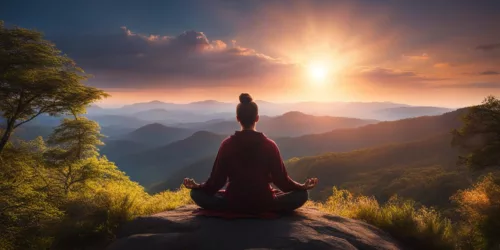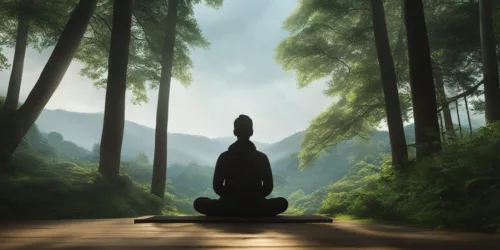Embracing Eco-Mindfulness in Forest Ecosystems
As nature lovers, we understand the importance of connecting with the world around us, and what better place to do so than in the calming embrace of a forest? Eco-mindfulness in forest ecosystems, also known as nature therapy or forest bathing, offers a holistic approach to well-being and environmental consciousness.
Forest bathing is more than just a leisurely walk in nature; it is a transformative experience that engages all our senses and allows us to tap into the healing power of the natural world. By immersing ourselves in the forest, we can bridge the gap between humanity and nature, fostering a deep appreciation for the interconnectedness of all living things.
Trees, the pillars of forest ecosystems, play a vital role in this practice. They release natural compounds called phytoncides, which have been scientifically proven to lower stress hormone levels and enhance immune system activity. As we engage our senses, we can fully experience the sights, sounds, scents, textures, and overall beauty of the forest, providing moments of stillness, mindfulness, and connection.
In our increasingly urbanized society, where people spend less time in nature and more time indoors, embracing forest bathing becomes essential. This practice allows us to rekindle our bond with the natural world, cultivate eco-awareness, and promote sustainable living. By immersing ourselves in forest healing, we can develop a deeper appreciation for the therapeutic power of trees and commit ourselves to the preservation of our environment.
Key Takeaways:
- Forest ecosystems offer a sanctuary for eco-mindfulness and nature therapy.
- Forest bathing involves engaging all our senses and connecting with the healing power of nature.
- Trees release phytoncides that can lower stress levels and enhance immune system activity.
- Forest bathing bridges the gap between humanity and nature, fostering eco-awareness.
- Engaging in forest healing strengthens our commitment to sustainable living and environmental preservation.
The Benefits of Eco-Meditation
Eco-meditation combines the benefits of meditation with the beauty of nature, offering a practice that nurtures the mind, body, and soul. In today’s fast-paced world, where stress and anxiety have become prevalent, eco-meditation provides a much-needed respite for our mental and physical well-being.
Studies have consistently shown that spending time in nature through eco-meditation has a positive impact on our mental health. It can reduce stress, anxiety, and depression, promoting overall well-being. Immersing ourselves in the natural environment allows us to disconnect from the pressures of daily life and reconnect with our inner selves.
Eco-meditation also provides an opportunity for introspection, self-reflection, and personal growth. As we connect with the natural world and our emotions, we gain a deeper understanding of ourselves and our place in the universe. This self-awareness enhances our ability to navigate life’s challenges and cultivate a sense of inner peace.
Furthermore, engaging in eco-meditation promotes physical health. Spending time in nature has been shown to lower blood pressure, improve immune function, and increase vitality. The healing power of the Earth’s energy can be tapped into through various practices such as walking in nature, meditating by a lake, or simply sitting under a tree.
Mindfulness and gratitude are essential components of eco-meditation. By fully immersing ourselves in the present moment and appreciating the abundance and beauty of the natural world, we cultivate a deep sense of gratitude. This awareness of the interconnectedness of all living beings fosters a sense of harmony within ourselves and with the environment.
By incorporating eco-meditation into our daily lives, we can experience lasting peace, balance, and well-being. It is a practice that nourishes our minds, rejuvenates our bodies, and uplifts our spirits. Let us embrace the transformative power of eco-meditation and embark on a journey towards holistic health and a deeper connection with our planet.
“In every walk with nature, one receives far more than he seeks.”
― John Muir
Overcoming Eco-Anxiety Through Nature Connection
Eco-anxiety, also known as climate change anxiety, is a pervasive emotional and mental state brought about by anxiety related to environmental threats and climate change. It’s a distressing feeling that many of us experience in today’s world. However, there is hope. We can find solace and healing through nature connection, which offers a powerful antidote to eco-anxiety.
Spending time in natural environments allows us to disconnect from the distressing news and connect with something greater than ourselves. It fosters a sense of peace and resilience that is crucial for navigating the challenges of climate change. Nature has a way of reminding us of the interconnectedness of all living things, and in that connection, we find renewed purpose and hope.
To deepen our nature connection and alleviate eco-anxiety, we can engage in activities that immerse us in nature. Whether it’s through gardening, hiking, or participating in environmental initiatives, these actions allow us to feel a sense of agency and empowerment. They remind us that we have the power to make a positive impact, both on ourselves and the world around us.
Education and understanding are key in our journey to overcome eco-anxiety. By learning about ecosystems, human impact on the environment, and global sustainability efforts, we equip ourselves with the knowledge needed to take meaningful action. In this knowledge, we find the motivation and inspiration to contribute to collective change.
Community engagement is also essential. By joining forces with like-minded individuals, we can support one another and make a greater impact. Together, we can amplify our voices and create positive change in our communities. By working together, we build resilience and find strength in unity.
Mindfulness and introspection are powerful tools that enhance our nature connection practices. By fully immersing ourselves in the present moment, expressing gratitude for the Earth’s gifts, and reflecting on our personal values and opportunities for positive change, we cultivate a deeper relationship with nature. In this relationship, we find solace, purpose, and the inspiration to transform our eco-anxiety into a catalyst for personal growth and positive environmental action.
FAQ
What is forest bathing?
Forest bathing, also known as shrinin-yoku forest therapy, is a practice of mindfulness that involves immersing oneself in the natural environment to promote well-being and a sense of calmness.
How is forest bathing different from a regular walk in nature?
Forest bathing is not just a walk in nature; it is a rejuvenating experience that allows individuals to engage all their senses and tap into the therapeutic essence of nature.
What is the role of trees in forest bathing?
Trees play a crucial role in forest bathing, releasing natural compounds called phytoncides that have been found to lower stress hormone levels and enhance immune system activity.
How does forest bathing benefit the mind, body, and soul?
Forest bathing is a holistic experience that encompasses the mind, body, and soul, offering moments of stillness, mindfulness, and connection with the natural world.
Why is forest bathing important in our urbanized society?
Forest bathing has become increasingly important in our urbanized society, where people are spending less time in nature and more time indoors.
How can eco-meditation benefit mental health?
Spending time in nature through eco-meditation has been shown to reduce stress, anxiety, and depression, promoting overall mental well-being.
What are the physical health benefits of eco-meditation?
Eco-meditation promotes physical health, with studies showing that spending time in nature can lower blood pressure, improve immune function, and increase vitality.
How can eco-meditation be practiced?
Eco-meditation can be practiced in various ways, such as walking in nature, meditating by a lake, or simply sitting under a tree, allowing individuals to tap into the healing power of the Earth’s energy.
What role do mindfulness and gratitude play in eco-meditation?
Mindfulness and gratitude are essential components of eco-meditation, as individuals fully immerse themselves in the present moment and appreciate the abundance and beauty of the natural world.
How can eco-anxiety be alleviated through nature connection?
Nature connection is a powerful antidote to eco-anxiety, offering solace, healing, and a renewed sense of purpose amidst the challenges of climate change.
What role does community engagement play in reducing eco-anxiety?
Community engagement plays a crucial role in reducing eco-anxiety, as individuals join forces with like-minded individuals to make a positive impact and support one another.
How can education and understanding help individuals cope with eco-anxiety?
Education and understanding about ecosystems, human impact on the environment, and global sustainability efforts empower individuals to take action and find hope in collective change.
How can eco-anxiety be transformed into personal growth and positive environmental action?
By fostering a deeper relationship with nature and finding solace in its embrace, individuals can transform eco-anxiety into a catalyst for personal growth and positive environmental action.
Source Links
- https://www.appenmedia.com/opinion/opinion-forest-bathing-allows-you-to-embrace-natures-healing-powers/article_9703cdb8-af26-11ee-82a0-a32d3a202d98.html
- https://silvotherapy.co.uk/articles/eco-anxiety-and-nature-connection
- https://www.aurahealth.io/blog/eco-meditation-connecting-with-natures-serenity






